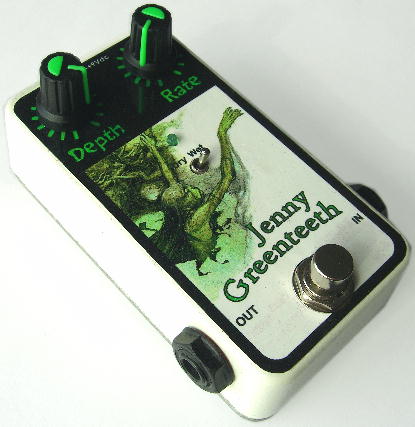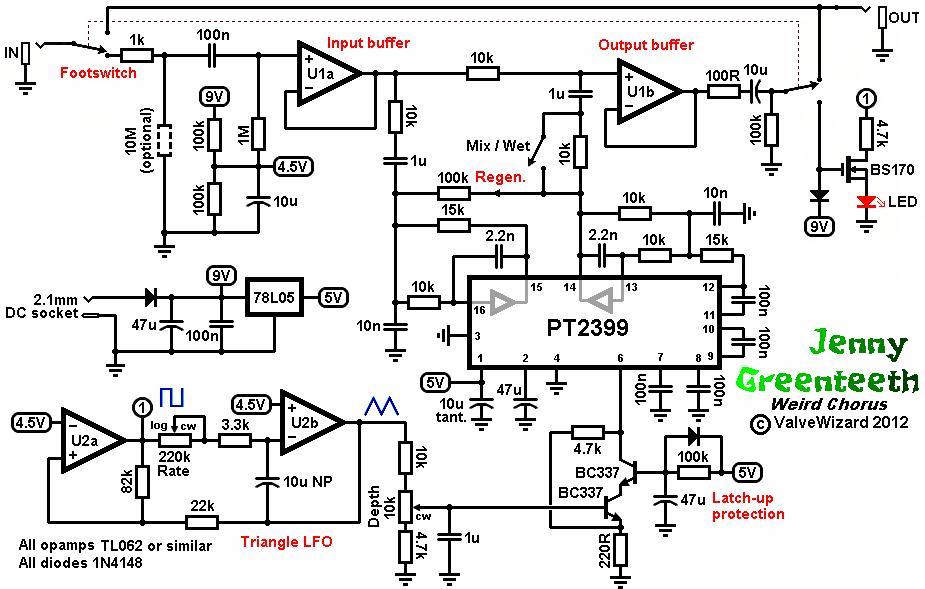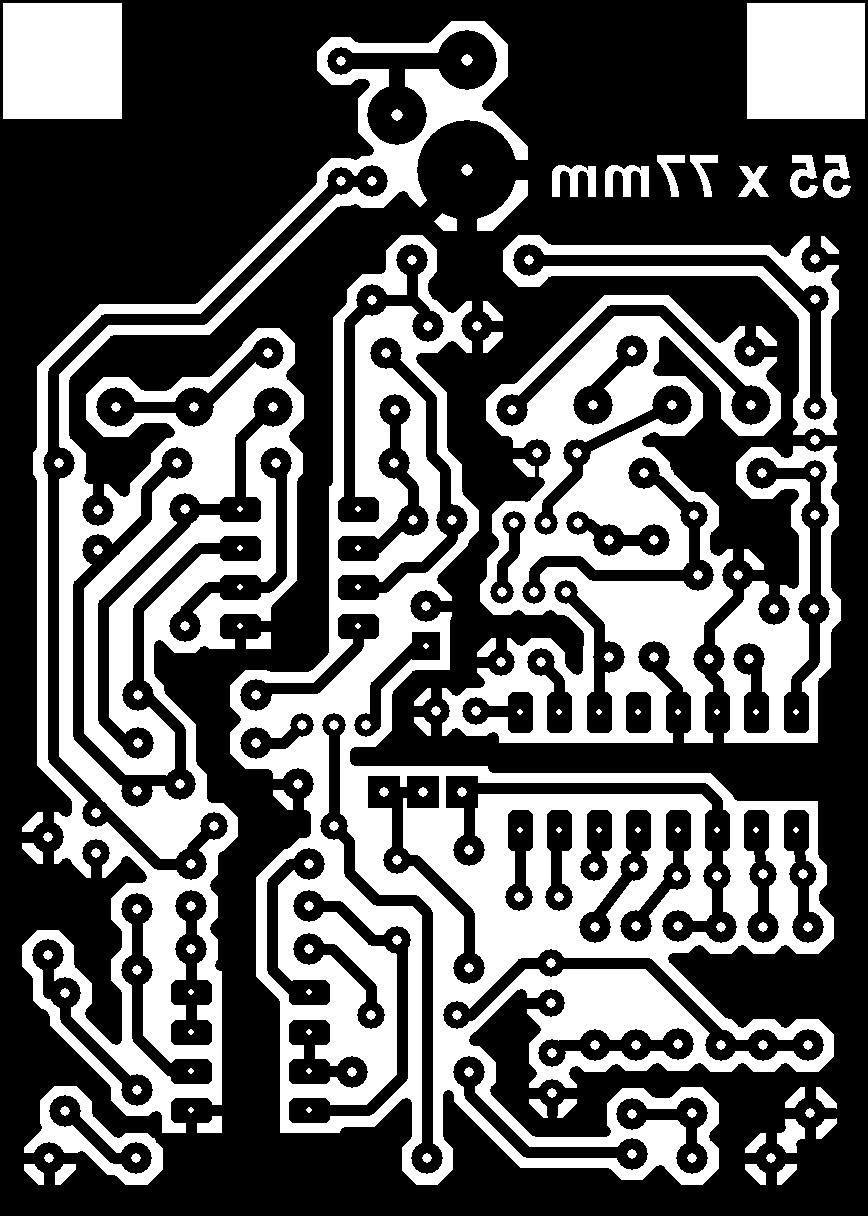|
Jenny Greenteeth: Weird Chorus / Pitch Bend / Ring Mod
 Jenny GreenTeeth started off as an experiment in making a chorus effect using the PT2399.
Chorus is created by passing the signal through a very short delay line, somewhere between about 8ms and 25ms.
The delay time is modulated and the delayed sgnal is mixed back with the original un-delayed signal.
Some feedback ('repeats') is often applied too, to thicken the effect.
The PT2399 has a minimum delay time of about 25ms, which is just short enough to do a thick chorus effect.
The more subtale chorus effects that a 'proper' chorus pedal would do are not avaialable as they require shorter delay times (
but I'm one of those people who only ever wants his chorus thick!).
However, as well as getting chorus I soon found that various other unexpected effects could also be had for free,
including pitch bend and a kind of ring modulation.
That's why I've called it 'weird chorus'.
Jenny GreenTeeth started off as an experiment in making a chorus effect using the PT2399.
Chorus is created by passing the signal through a very short delay line, somewhere between about 8ms and 25ms.
The delay time is modulated and the delayed sgnal is mixed back with the original un-delayed signal.
Some feedback ('repeats') is often applied too, to thicken the effect.
The PT2399 has a minimum delay time of about 25ms, which is just short enough to do a thick chorus effect.
The more subtale chorus effects that a 'proper' chorus pedal would do are not avaialable as they require shorter delay times (
but I'm one of those people who only ever wants his chorus thick!).
However, as well as getting chorus I soon found that various other unexpected effects could also be had for free,
including pitch bend and a kind of ring modulation.
That's why I've called it 'weird chorus'.

The circuit shares a lot in common with my SmallTime delay,
except the delay time is made as short as possible and a low-frequency oscillator (LFO) has been added.
Also, the amount of feedback or 'repeats' is fixed with a 100k resistor (labelled 'regen').
I found that only a little regeneration was necessary, and there wasn't much advantage in making it variable.
Although the PT2399 is capable of a minimum delay time of 25ms, it does have a nasty habut of latching-up on power up and burning itself out
if the delay resistance (pin 6) is less than 1k. Therefore, I added a transistor with a slow RC filter connected to the base.
When power is frst aplied the transistor is off and the delay resistance is several k-ohms which does not cause latch-up,
but as the cap charges the transistor eventually turns on and saturates, and basically becomes a short circuit.
This leaves the second transistor available to modulate the delay time.
The delay time is determined by the current sucked out of pin 6. The lower transistor is therefore arranged as a simple
current sink, varying the delay time in proportion to the voltage applied to its base.
The LFO is a classic triangle-wave oscillator made from two opamps. I recommend a TL062 here because it consumes less
current than the usual TL072, and less current means less chance of ticking due to modulation of the power rail.
The LFO frequency is variable from about 1Hz to about 10Hz with the rate pot.
To get a smooth variation in rate with pot rotation I used a log pot, but wired it up 'backwards' so the rate increases
when you turn it anticlockwise.
This might seem a bit counter-intuitive at first, but it's a lot cheaper than buying an anti-log pot.
The traingle LFO output is then sent to the depth pot and then to the base of the delay-modulating transistor.
The resistors around the depth pot carefully set the average DC voltage to the transistor so the delay varies smoothly around a central value, otherwise you get thumping.
As an added feature, one of the oscllator opamps (which produces a square wave) is used to feed the Millennium bypass LED, so it flashes in time with the oscillator.
One final and important feature is the wet/dry switch.
When the switch is open the wet and dry signals are mixed together equally, which creates the ordinary chorus sound among others.
But when the switch is closed the wet path effectively overrides the dry path completely, so you get 100% wet.
This produces some of the more extreme pitchbend flavours.
 By the way, if you're wondering who Jenny Greenteeth is, she is a cautionary character from English folklore;
she wait just beneath the surface of ponds and rivers to pull in and drown anyone who strays too close.
I named the pedal after her because a lot of the effects it produces sound quite 'watery' to my ears!
By the way, if you're wondering who Jenny Greenteeth is, she is a cautionary character from English folklore;
she wait just beneath the surface of ponds and rivers to pull in and drown anyone who strays too close.
I named the pedal after her because a lot of the effects it produces sound quite 'watery' to my ears!
Technical details:
Input impedance = 1M ohms
Output impedance = 100 ohms
Current consumption = 22mA when active. (Like all delay effects it is fairly current hungry, so there is not much
point making it battery powered.)
You will find the schematic, PCB layout and BOM here (288kB).
Note: If you print the PCB layout make sure your printer settings are set to "zero page scaling".
I built mine into a Cliff enclosure from Gapco, but it will also fit into a Hammond 1590B
Soundclip: Played directly into computer sound card with some EQ for a cab sim.
It's a bit pathetic I know! I will try to do a better one at some point.
|